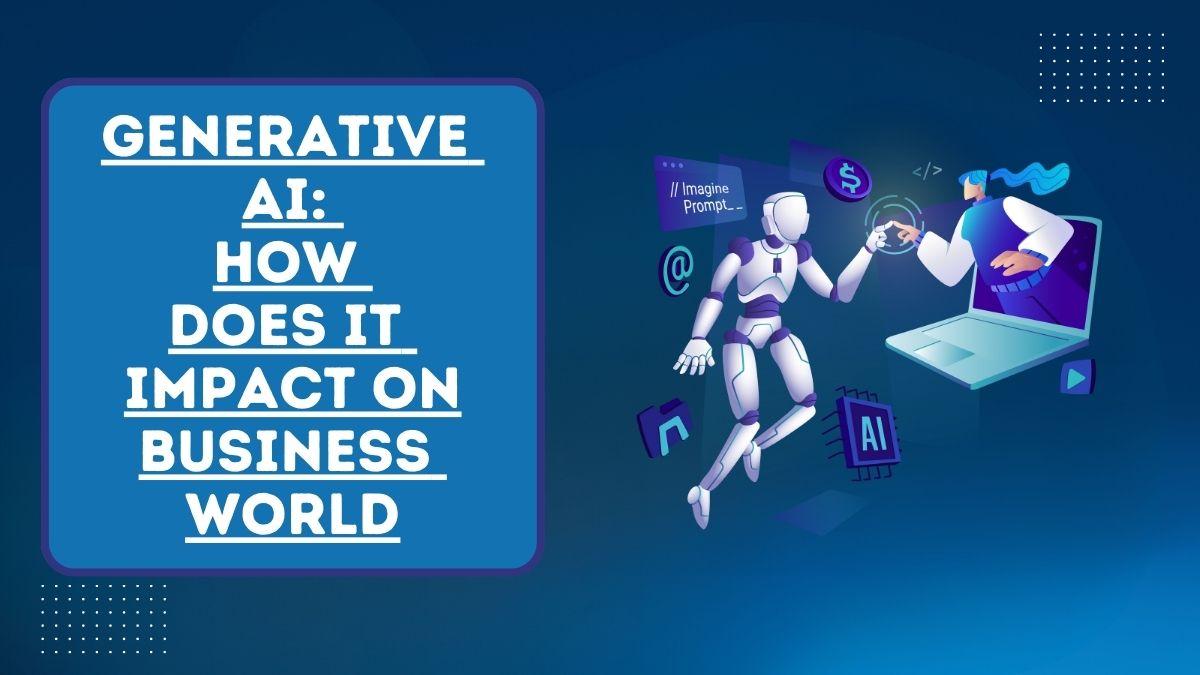Emerging technology in artificial intelligence, called generative AI, has the power to completely alter how businesses operate. The corporate environment can be significantly changed by generative AI through task automation and the creation of new growth prospects.
In this article, we’ll examine the idea of generative AI, its various forms, advantages and disadvantages, and the moral ramifications of using it in a corporate setting.
How Does Generative AI Work and What Is It?
An artificial intelligence model family called “generative AI” may create new material from previously gathered information, such as text, images, or videos. Since these models have been trained on massive datasets to find patterns and relationships within the data, they can produce new content comparable to the training data in style and structure.
Generative AI has several applications in the business world, from enhancing customer service to automating production processes. As technology continues to develop, we can anticipate more cutting-edge AI applications in the future.
Generative AI Types and Important Applications
Generative AI is an advanced technology that has revolutionized commercial processes. It uses machine learning and algorithms to generate fresh text, images, and even entire items. Different types of generative AI models exist, each with specific business uses.
1. Generation of Text
Text generation models can produce text that resembles human writing on the input data they are trained on. Examples of next-generation AI models include OpenAI’s GPT-3 and GPT-4. These models are employed for a variety of activities, including:
- Creating content: AI can generate blog entries, social media postings, and marketing material.
- Automated customer service: AI can answer frequently asked questions or produce responses to consumer requests.
- Personalized messaging: AI can customize content for each user, increasing the success of marketing initiatives.
2. Image Production
Similar to GANs (Generative Adversarial Networks), image generation models can generate new images based on relationships and patterns found in their training data. Business applications include:
- Designing products: AI can save time and effort by generating fresh design ideas.
- Advertising: AI-generated visuals can be used in personalized and targeted ads.
- Dataset augmentation: AI-generated photos can increase the size of training datasets for other AI models, enhancing their performance.
3. Video Production
Video generation models can produce entirely new videos or remixes of existing videos. Business applications include:
- Advertising: AI can create advertising videos or modify content to appeal to specific audiences.
- Training and education: AI-generated videos can provide employees with personalized learning opportunities.
- Simulation: AI can provide lifelike simulations for fields like architecture and car design.
Generative AI models can also produce 3D objects, audio, virtual environments, procedural designs, and more. These AI technologies enable creativity and innovation in industries such as design, media, and entertainment.
Generative AI has the capability to create ground-breaking discoveries when joined with human ingenuity, ushering in a period of prosperity, advancement, and opportunity.
Generative AI in Business: Potential Advantages and Disadvantages
This technology has plenty of benefits for many business organizations, such as increased production, efficiency, and effectiveness. It has the future to free up time and resources for workers to focus on activities by automating a variety of jobs.
Additionally, generative AI promotes creativity and possible to create new services, which supports to accelerates growth.
But also important to be aware of any potential disadvantages. Implementing generative AI models may be difficult for small businesses or organizations since it needs a lot of power and knowledge.
Additionally, the generated content may be of bad quality or contain mistakes, which could impact a company’s reputation.
Ethics of Artificial Intelligence in Business
Several ethical issues are raised by the use of generative AI in business, including:
- Bias: Artificial intelligence (AI) models can reinforce preexisting biases found in the training data, resulting in biased outputs.
- Privacy: Using a person’s personal information to train AI models may violate that person’s right to privacy.
- Misuse or abuse: Fake news and other kind of fake information can be produced using this AI technology.
To alleviate these worries, businesses must put strict ethical standards and supervision procedures in place to control the appropriate and moral usage of generative AI. Regulatory frameworks can also be essential to guarantee AI’s ethical deployment responsibly.
Examples of Generative AI in Business in the Real World
Several businesses are already using generative AI to achieve their objectives:
- Stitch Fix: Stitch Fix utilizes AI based on customer data to generate personalized clothing recommendations. Generative models analyze users’ style preferences, sizes, and price points to provide highly personalized recommendations at scale.
- Adobe: Adobe creates AI-powered image and video creation tools that enable designers to produce new content more quickly. AI-generated graphics can accelerate creative iterations, marketing campaigns, and the work of creative professionals in various applications.
- OpenAI’s GPT-3 and GPT-4: OpenAI’s GPT-3 and GPT-4 use by businesses for content creation, translation, and customer assistance. For example, Mailchimp employs GPT models to create customized email responses to customer inquiries, delivering quick and reliable replies.
- NVIDIA’s StyleGAN2: NVIDIA’s StyleGAN2 is used to generate realistic representations of products from a small sample of photos. This innovation expands product catalogues and reduces the need for 3D modelling.
- Netflix: Netflix uses generative models to improve user experiences and offer personalized TV and movie recommendations for its customers.
- Prisma: Prisma employs those models to offer self-service photo editing features, transforming common photographs into works of art in various artistic genres.
- NVIDIA’s Interactive: NVIDIA’s Interactive DL Laboratory, in collaboration with Mercedes-Benz, generates exterior designs for sedans through a procedural process, enabling the creation of unique designs with less manual work.
Conclusion
The business sector could be significantly impacted by technology developed by generative AI development company for enhancing productivity, efficiency, and creativity. Addressing issues like bias, privacy, and technology abuse is crucial through reasonable standards, regulation, and oversight. Real-world examples demonstrate the revolutionary potential of generative AI, emphasizing the importance of learning and adapting to use it while completely minimizing risks.
It is a promising technological advancement that can change industries and advance society. Businesses that use generative AI will be better positioned to thrive in the changing business environment.



